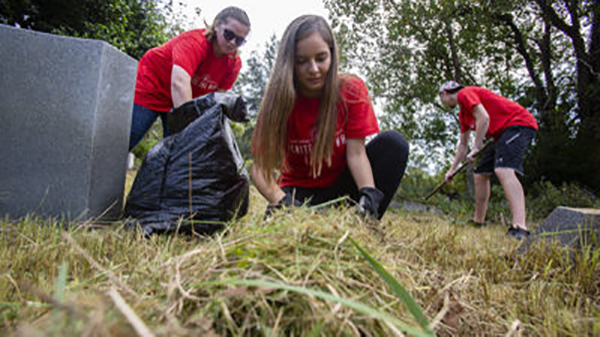Paint stroke by paint stroke, the images began to appear. Mardi Gras masks. The USS Alabama. Magnolia blossoms.
And “Home of the Tigers,” the mascot of the James M. Seals Jr. Community Center in Mobile, where several recreational teams, including a wheelchair basketball team, play regularly.
Rhonda McDaniel, facility supervisor at Seals Community Center, said the mural has already gotten a lot of attention. “Everybody, young and old, seems to like it,” she said. “It enhances the gym area.”
The center’s new mural was just one of the projects University of Mobile (UM) students worked on Oct. 19 as part of the university’s 8th annual Project Serve.
More than 1,000 faculty and staff volunteered at more than 60 sites in Mobile and Baldwin counties. Volunteers spread out to help at local food pantries and soup kitchens, at elementary schools and recreation centers and a variety of other community and ministry locations.
‘Show off Christ’
One of the mural painters was UM student Caitlyn Boley, who said Project Serve is all about being imago dei, or image-bearers of Christ. The phrase was printed on the back of the red shirts Project Serve participants wore, and it’s a reminder to the students, Boley said.
It’s “the reason we come out into the community and paint murals and show off Christ and what He’s doing in our school,” she said. “We just want to represent Him well in all that we do.”
Project Serve has been around for a few years, but in the past couple of years, every Friday has been set apart as a Focus Friday — a day with no classes when students can engage in service projects.
Focus Fridays and Project Serve are all part of UM’s culture of community service, said UM President Timothy Smith.
“It’s an opportunity to continue our mission,” Smith said. “Students get to go out every Friday to serve their community, but (Project Serve) is an opportunity for us to all go out together to fulfill our Great Commission calling.”
Students regularly use Focus Fridays to volunteer locally, and many spend fall and spring breaks traveling to inner cities across the nation to partner with churches. When a natural disaster occurs, students are eager to support recovery efforts with manpower, donations and prayers.
But Project Serve is an opportunity for everyone to work together on a single day to make a difference in the university’s backyard, organizers said.
This year’s Project Serve began with an opening rally on the front steps of Weaver Hall featuring a selection of music by RamCorps, UM’s brass and percussion ensemble.
A prayer and commission by Smith and a group photo followed, and then the sea of red-shirted volunteers dispersed. Students and professors from the Department of Natural Sciences in the College of Arts and Sciences drove less than two miles to Evangel Christian School, where they taught elementary students about astronomy and chemistry.
Students and faculty from the School of Health and Sports Science worked at Oaklawn Memorial Cemetery, where they mowed grass, weeded graves and cleared debris from tombstones bearing the names of veterans buried at the historic cemetery.
Local photojournalist Fran Barber has worked on documenting the graves of veterans at Oaklawn. She said 700 veteran graves have so far been discovered and more than 2,000 may be located there.
Barber said that during World War II, black war heroes were not allowed to be buried in some established cemeteries.
The parcel of land was donated to these heroes and their families, and the community established Oaklawn as a nonperpetual cemetery. The area began to fill and, with the land ownership rights in limbo, the grass and weeds took over.
“This cemetery is 22 acres and there are parts we can’t even access yet,” Barber said.
‘A part of history’
As volunteers from UM worked, Barber followed them to document the graves that they uncovered.
“These heroes served our country and then they were just forgotten,” she said.
Barber told the students their work at Oaklawn is something they can tell their children about.
“You’re a part of history now.” (UM, Carrie Brown McWhorter contributed)






Share with others: